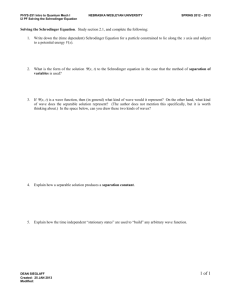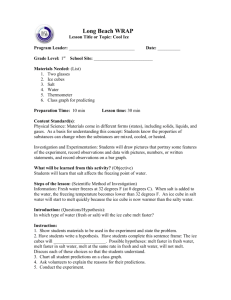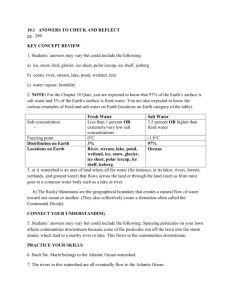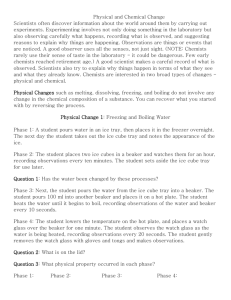Schrodinger equation
advertisement
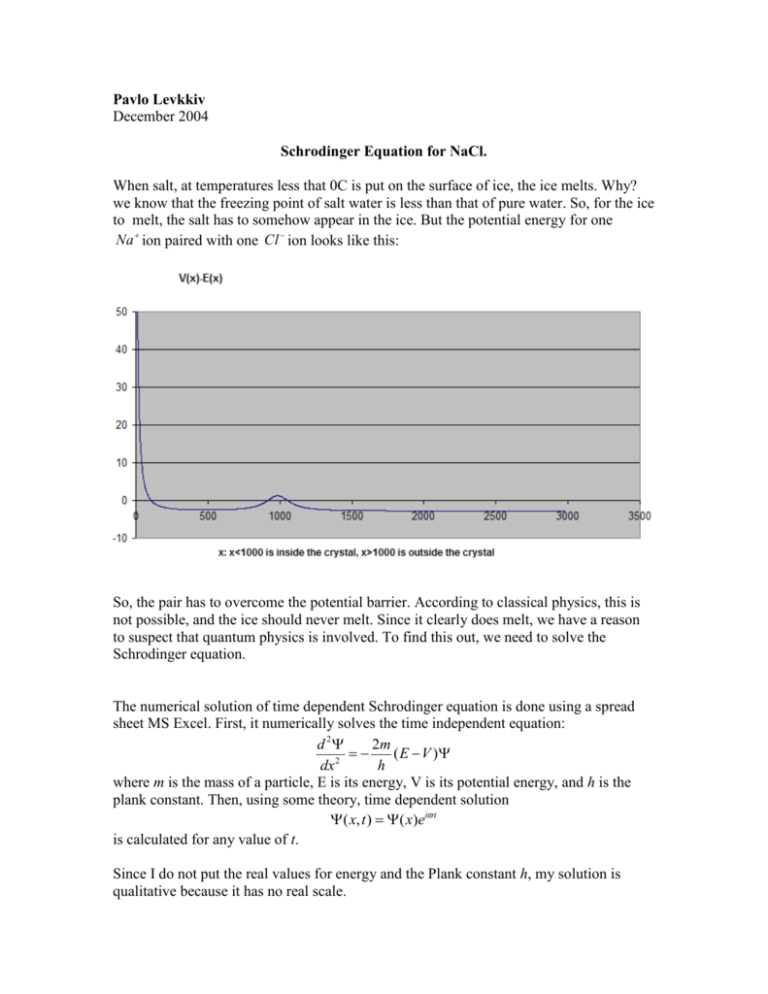
Pavlo Levkkiv December 2004 Schrodinger Equation for NaCl. When salt, at temperatures less that 0C is put on the surface of ice, the ice melts. Why? we know that the freezing point of salt water is less than that of pure water. So, for the ice to melt, the salt has to somehow appear in the ice. But the potential energy for one Na ion paired with one Cl ion looks like this: So, the pair has to overcome the potential barrier. According to classical physics, this is not possible, and the ice should never melt. Since it clearly does melt, we have a reason to suspect that quantum physics is involved. To find this out, we need to solve the Schrodinger equation. The numerical solution of time dependent Schrodinger equation is done using a spread sheet MS Excel. First, it numerically solves the time independent equation: d 2 2m ( E V ) 2 dx h where m is the mass of a particle, E is its energy, V is its potential energy, and h is the plank constant. Then, using some theory, time dependent solution ( x, t ) ( x)ei t is calculated for any value of t. Since I do not put the real values for energy and the Plank constant h, my solution is qualitative because it has no real scale. To get the time independent solution, first, I tried to solve it this way: If y is a function of x, and we pick three points: ( x1 , y1 ),( x2 , y2 ),( x3 , y3 ) each separated by a small dx, we can approximate the second derivative d2y at y2 by dx 2 y3 y2 y2 y1 dx . If we have an equation y '' f ( x) y , at y we can substitute y’’ y2 '' dx 2 dx y3 y2 y2 y1 dx dx f ( x ) y . Solving for y : with its approximation and get 2 2 3 dx 2m y3 f ( x2 ) y2 dx 2 2 y2 y1 . Using this equation with f ( x) ( E V ) , we can find h any yn from yn 1 and yn2 . In MS Excel, I put the values of y1 and y2 in A1 and A2, and yn f ( xn 1 ) yn 1dx 2 2 yn 1 yn 2 from A3 to A3000. This resulted in a solution of the equation. However, for most types of potentials, there are more than one solution. The solution obtained by this method did not make sense. So I tried another way: When n=4, y4 f ( x3 ) y3dx 2 2 y3 y2 . For n=3: y3 f ( x2 ) y2 dx 2 2 y2 y1 y3 y1 y2 f ( x2 ) dx 2 2 Plugging into the n=4, y4 f ( x3 ) y3dx 2 2 y3 y3 y1 f ( x2 )dx 2 2 Here we have a way to find yn from yn 1 and yn3 , instead of yn 1 and yn2 This method gave solutions that agreed with the concepts of physics. However, I cannot understand why this worked better than the first one. Time dependence: According to “Modern physics” by Kenneth Krane, the solution to the time independent equation has the general form: ( x) A sin kx Bcos kx 2m E V h Using Euler’s identity, ( x) A ' ekx B ' e kx where A’ and B’ can be found from A and B. From the book, the time dependent equation is k ( x, t ) ( x)eit E hbar So, ( x, t ) ( A ' eikx B ' eikx )eit A ' ei ( kx t ) B ' ei ( kx t ) where the A’ term represents a wave of amplitude A '2 moving in the negative x direction while the B’ term represents a wave of amplitude B '2 moving in the positive x direction. So, I subtracted a sinkx from the original time independent solution, resulting in another trigonometric function. Then, the program finds the amplitude of each of the two waves, and sets a wave of the first amplitude moving to the left, and of the other moving to the right. That is what you see in the final solution. The real solution process is a little more complicated because I tried to get rid of discontinuities. Why and how is briefly described in the excel file schr1 (version 3).xls. Here is a program that solves the one-dimensional time dependent Schrodinger equation for any potential V(x). The Schrodinger equation: d 2 2m ( E V ) 2 dx h ( x, t ) ( x)eit To use the program, imagine that you observe a particle with mass m at x=o 1. Type the formula for the potential V(x) as a function of x (x=G26) in I26, copy it, and paste from I27 to I3025. 2. Type the energy (in h*joules) the particle has when you observe it in H26. Press enter. 3. Type the amount of time after the moment you observe it at which you want to see the solution of the equation in BA141. Press enter. ( x, t ) 2 ( x, t ) 4. On the right, you will see . This solution can be interpreted qualitatively (approximately) as the wave function for a Na ion paired with a Cl ion on the edge of a salt crystal. By plugging in different values for t, you can see that the pair sometimes finds itself on the outside of the crystal. This is why, if you put salt at temperature below 0C on ice, the salt atoms will penetrate into the ice and melt it. According to classical physics, this would not be possible. . This part calculates y=PSI(x) I obtain the solutiojn by solving from 0 to 500 in positive direction of x and from 3000 to 500 in negative direction of x. This is because otherwise I cannot get the decaying exponential function as x increases after the potential barrier (x=1000). Thi metod produces discontinuity at x=500, which is removed in columns AL-AR. y=PSI y'' # y^2 dx (V(x)-E(x))m x E(x) V(x) E 0 0 0 0.01 #DIV/0! 0 0.7 #DIV/0! 0.000166674 -6.66651331 1 2.78E-08 0.01 39997.24 -0.01 0.7 10000.01 0.001 0.466238004 2 0.000001 0.01 9997.24 -0.02 0.7 2500.01 0.001786702 -3.59974725 3 3.19E-06 0.01 4441.684 -0.03 0.7 1111.121 0.002933378 -2.22008503 4 8.6E-06 0.01 2497.24 -0.04 0.7 625.01 0.004302064 -3.30856263 5 1.85E-05 0.01 1597.24 -0.05 0.7 400.01 0.006001605 -3.15079106 6 3.6E-05 0.01 1108.351 -0.06 0.7 277.7878 0.008016225 -3.56061795 7 6.43E-05 0.01 813.5667 -0.07 0.7 204.0917 0.010386908 -3.66724685 8 0.000108 0.01 622.2402 -0.08 0.7 156.2601
